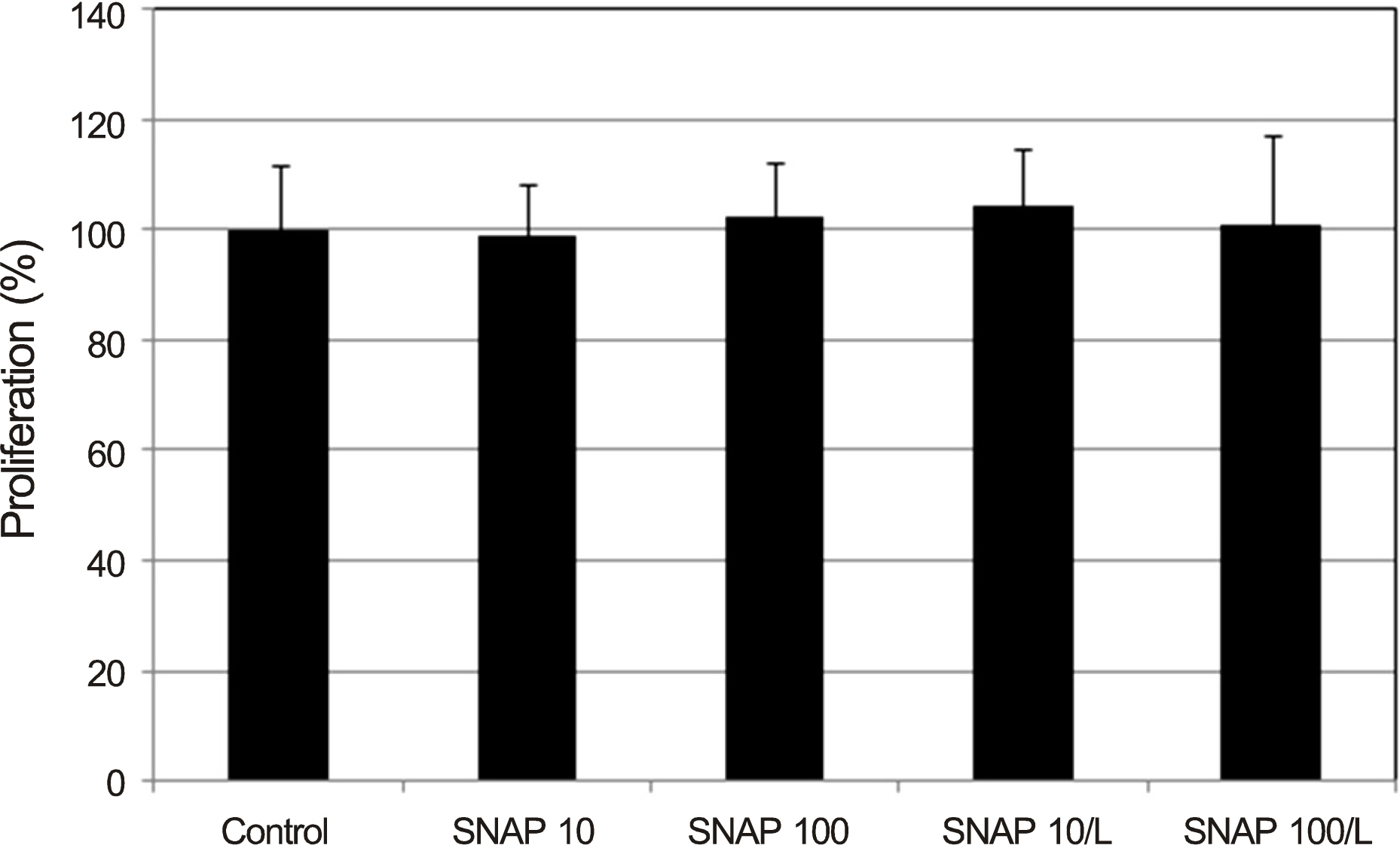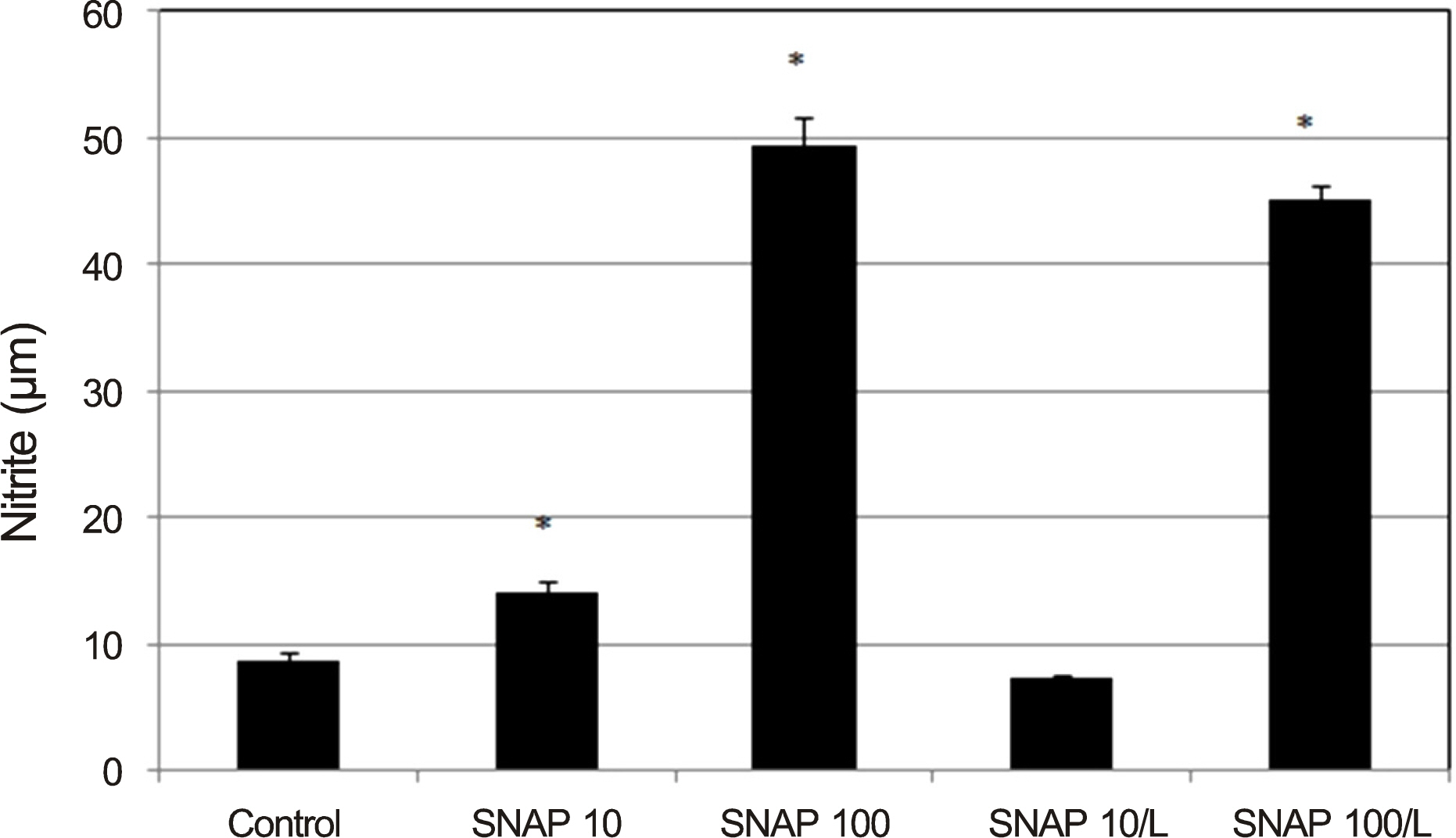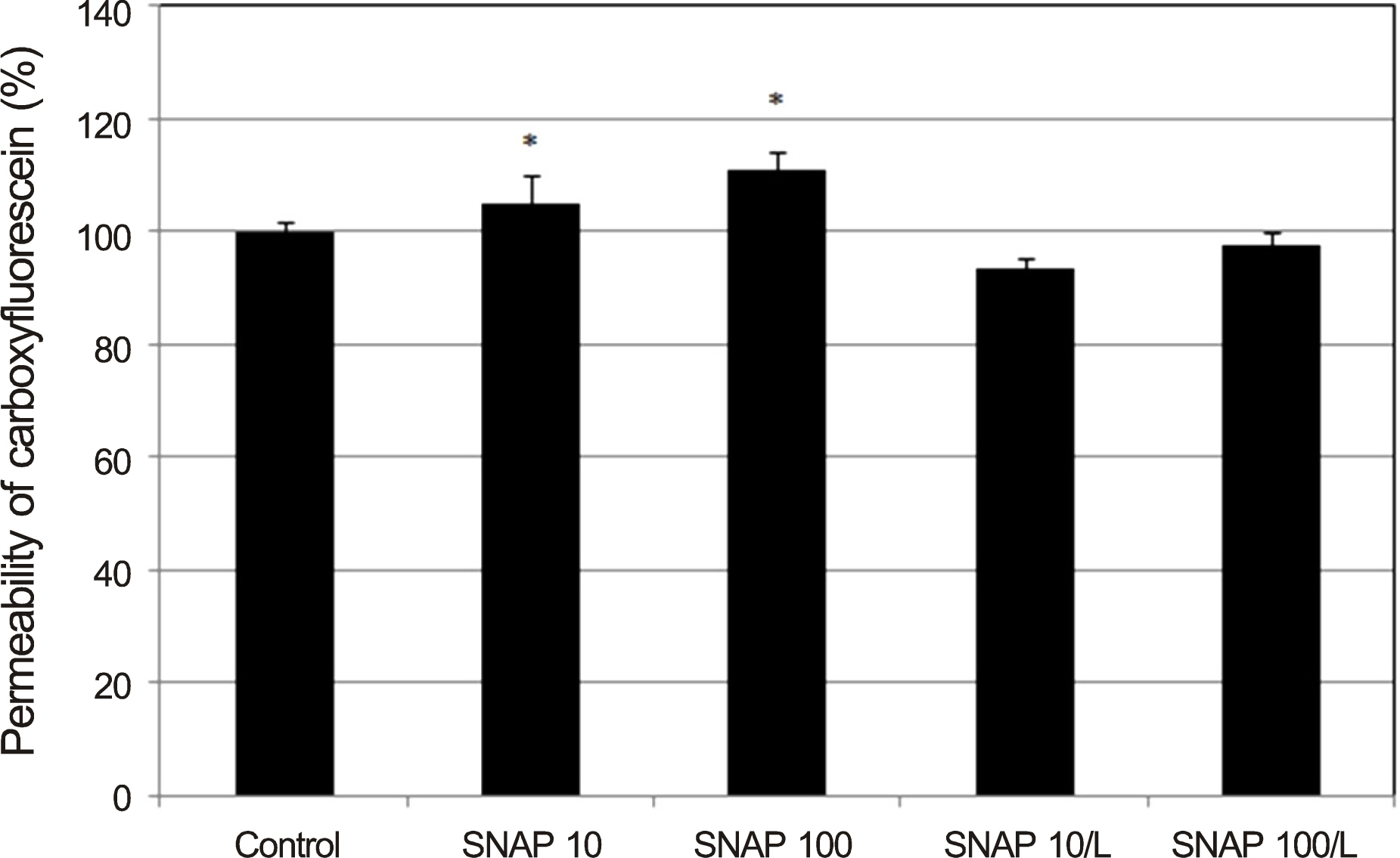J Korean Ophthalmol Soc.
2015 May;56(5):771-775. 10.3341/jkos.2015.56.5.771.
Effect of Nitric Oxide on the Permeability of Trabecular Meshwork Cell Monolayer
- Affiliations
-
- 1Department of Ophthalmology, Catholic University of Daegu School of Medicine, Daegu, Korea. jwkim@cu.ac.kr
- KMID: 2121178
- DOI: http://doi.org/10.3341/jkos.2015.56.5.771
Abstract
- PURPOSE
To investigate the effects of nitric oxide (NO) on the permeability of cultured human trabecular meshwork cell (HTMC) monolayer.
METHODS
HTMCs were cultured until confluency in the Transwell inner chamber and then exposed to 0, 10 or 100 microm S-nitroso-N-acetyl-DL-penicillamine (SNAP) and 0.5 mm L-NG-Nitroarginine methyl ester (L-NAME) for 24 hours. Permeabilities of carboxyfluorescein through the HTMC monolayer were measured using a spectrofluorometer after 2 hours in the outer chamber. Cellular viabilities and production of NO were assessed using 3-(4, 5-dimethylthiazol-2-yl)-2, 5-diphenyltetrazolium bromide (MTT) and Griess assay, respectively.
RESULTS
The cellular survival was not affected by 10 or 100 microm SNAP (p > 0.05) but NO production increased in a dose-dependent manner (p < 0.05). SNAP significantly increased the permeability of carboxyfluorescein through the HTMC monolayer in a dose-dependent manner compared with non-exposed control (p < 0.05). The endothelial NO synthase inhibitor L-NAME abolished SNAP-induced increase of the carboxyfluorescein permeability (p > 0.05).
CONCLUSIONS
NO increased the permeability of carboxyfluorescein through the HTMC monolayer in a dose-dependent manner. Thus, NO could increase trabecular outflow by increasing the permeability of trabecular cell layer in addition to trabeular messwork (TM) relaxation.
MeSH Terms
Figure
Cited by 2 articles
-
Effect of Rho Kinase Inhibitor on the Production of Nitric Oxide in Trabecular Meshwork Cells
Jae Woo Kim, Keun Hae Kim, Seok Jin Hwang
J Korean Ophthalmol Soc. 2016;57(4):650-656. doi: 10.3341/jkos.2016.57.4.650.Effect of Tetrahydrozoline on the Permeability of Trabecular Meshwork Cell Monolayer
Seok Jin Hwang, Jae Woo Kim
J Korean Ophthalmol Soc. 2017;58(1):69-73. doi: 10.3341/jkos.2017.58.1.69.
Reference
-
References
1. Alvarado J, Murphy C, Juster R. Trabecular meshwork cellularity in primary open-angle glaucoma and nonglaucomatous normals. Ophthalmology. 1984; 91:564–79.
Article2. Rohen JW, Lütjen-Drecoll E, Flügel C, et al. Ultrastructure of the trabecular meshwork in untreated cases of primary open-angle glaucoma (POAG). Exp Eye Res. 1993; 56:683–92.3. Nathanson JA, McKee M. Identification of an extensive system of nitric oxide-producing cells in the ciliary muscle and outflow path-way of the human eye. Invest Ophthalmol Vis Sci. 1995; 36:1765–73.4. Geyer O, Podos SM, Mittag T. Nitric oxide synthase activity in tissues of the bovine eye. Graefes Arch Clin Exp Ophthalmol. 1997; 235:786–93.
Article5. Meyer P, Champion C, Schlötzer-Schrehardt U, et al. Localization of nitric oxide synthase isoforms in porcine ocular tissues. Curr Eye Res. 1999; 18:375–80.
Article6. Wiederholt M, Sturm A, Lepple-Wienhues A. Relaxation of trabecular meshwork and ciliary muscle by release of nitric oxide. Invest Ophthalmol Vis Sci. 1994; 35:2515–20.7. Behar-Cohen FF, Goureau O, D'Hermies F, Courtois Y. Decreased intraocular pressure induced by nitric oxide donors is correlated to nitrite production in the rabbit eye. Invest Ophthalmol Vis Sci. 1996; 37:1711–5.8. Nathanson JA, McKee M. Alterations of ocular nitric oxide synthase in human glaucoma. Invest Ophthalmol Vis Sci. 1995; 36:1774–84.9. Araie M. Carboxyfluorescein. A dye for evaluating the corneal endothelial barrier function in vivo. Exp Eye Res. 1986; 42:141–50.
Article10. Araie M. Barrier function of corneal endothelium and the intraocular irrigating solutions. Arch Ophthalmol. 1986; 104:435–8.
Article11. Tsuboi S, Pederson JE. Permeability of the isolated dog retinal pigment epithelium to carboxyfluorescein. Invest Ophthalmol Vis Sci. 1986; 27:1767–70.12. Blair NP, Rusin MM. Blood-retinal barrier permeability to carboxyfluorescein and fluorescein in monkeys. Graefes Arch Clin Exp Ophthalmol. 1986; 224:419–22.
Article13. Grimes PA. Carboxyfluorescein transfer across the blood-retinal barrier evaluated by quantitative fluorescence microscopy: comparison with fluorescein. Exp Eye Res. 1988; 46:769–83.
Article14. Nakagawa S, Usui T, Yokoo S, et al. Toxicity evaluation of anti-glaucoma drugs using stratified human cultivated corneal epithelial sheets. Invest Ophthalmol Vis Sci. 2012; 53:5154–60.
Article15. Kameda T, Inoue T, Inatani M, et al. The effect of Rho-associated protein kinase inhibitor on monkey Schlemm's canal endothelial cells. Invest Ophthalmol Vis Sci. 2012; 53:3092–103.
Article16. Rao PV, Deng PF, Kumar J, Epstein DL. Modulation of aqueous humor outflow facility by the Rho kinase-specific inhibitor Y-27632. Invest Ophthalmol Vis Sci. 2001; 42:1029–37.17. Mosmann T. Rapid colorimetric assay for cellular growth and survival: application to proliferation and cytotoxicity assays. J Immunol Methods. 1983; 65:55–63.
Article18. Freimoser FM, Jakob CA, Aebi M, Tuor U. The MTT [3-(4,5-di-methylthiazol-2-yl)-2,5-diphenyltetrazolium bromide] assay is a fast and reliable method for colorimetric determination of fungal cell densities. Appl Environ Microbiol. 1999; 65:3727–9.
Article19. Green LC, Wagner DA, Glogowski J, et al. Analysis of nitrate, nitrite, and [15N]nitrate in biological fluids. Anal Biochem. 1982; 126:131–8.
Article20. Stamer WD, Lei Y, Boussommier-Calleja A, et al. eNOS, a pressure-dependent regulator of intraocular pressure. Invest Ophthalmol Vis Sci. 2011; 52:9438–44.
Article21. Predescu D, Predescu S, Shimizu J, et al. Constitutive eNOS-de-rived nitric oxide is a determinant of endothelial junctional integrity. Am J Physiol Lung Cell Mol Physiol. 2005; 289:L371–81.
Article22. Pfeilschifter J, Eberhardt W, Huwiler A. Nitric oxide and mechanisms of redox signalling: matrix and matrix-metabolizing en-zymes as prime nitric oxide targets. Eur J Pharmacol. 2001; 429:279–86.
Article23. Dismuke WM, Mbadugha CC, Ellis DZ. NO-induced regulation of human trabecular meshwork cell volume and aqueous humor outflow facility involve the BKCa ion channel. Am J Physiol Cell Physiol. 2008; 294:C1378–86.
Article
- Full Text Links
- Actions
-
Cited
- CITED
-
- Close
- Share
- Similar articles
-
- Effect of Tetrahydrozoline on the Permeability of Trabecular Meshwork Cell Monolayer
- Effects of Hydrogen Sulfide and Nitric Oxide on the Permeability of Cultured Trabecular Meshwork Cells
- Effect of Latanoprostene Bunod on the Permeability of Trabecular Meshwork Cells
- Effect of Bimatoprost on the Permeability of Trabecular Meshwork Cell Monolayer
- Effect of Rho Kinase Inhibitor on the Production of Nitric Oxide in Trabecular Meshwork Cells




